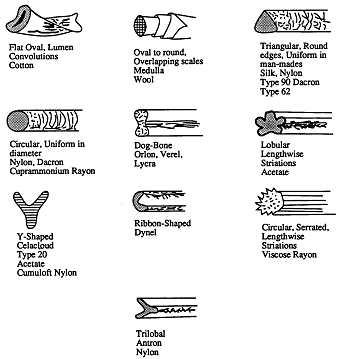Basic Textile Fiber Properties
There are several primary properties necessary for a polymeric material to make an adequate fiber.Certain other fiber properties increase its value and desirability in its intended end-use but are not necessary properties essential to make a fiber. Such secondary properties include moisture absorption characteristics, fiber resiliency, abrasion resistance, density, luster, chemical resistance, thermal characteristics, and flammability.
Some Primary Properties of Textile Fibers are:
- Fiber length to width ratio,
- Fiber uniformity,
- Fiber strength and flexibility,
- Fiber extensibility and elasticity, and
- Fiber cohesiveness.
How heat affects Textile Fiber's properties
Examples of Fiber Shapes

- Softening, melting, or decomposition temperatures
- Tendency of the fiber and fabric to shrink when heat-relaxed, or stretch when heated and under tension
- Ability of the fabric to heat set
- Ability of the fabric to function properly at elevated temperatures in one time or repeated use
- Ability of the fabric to function properly at room temperature (or some other lower temperature) after exposure at high temperature for a given period of time
Thermal Properties of Common Fibers
| Fiber | Melting Point | Softening Sticking Point | Safe Ironing Temperature | |||
|---|---|---|---|---|---|---|
| °F | °C | °F | °C | °F | °C | |
| Natural Fibers | ||||||
| Cotton | Nonmelting | 425 | 218 | |||
| Flax | Nonmelting | 450 | 232 | |||
| Silk | Nonmelting | 300 | 149 | |||
| Wool | Nonmelting | 300 | 149 | |||
| Manmade Fibers | ||||||
| Acetate | 446 | 230 | 364 | 184 | 350 | 177 |
| Arnel Triacetage | 575 | 302 | 482 | 250 | 464 | 240 |
| Acrylic | 400-490 | 204-254 | 300-350 | 149-176 | ||
| Aramid | Does not melt, carbonizes above 800F | |||||
| Glass | 1400-3033 | |||||
| Modacrylic | 410 | 210 | 300 | 149 | 200-250 | 93-121 |
| Novoloid | Nonmelting | |||||
| Nylon6 | 414 | 212 | 340 | 171 | 300 | 149 |
| Nylon66 | 482 | 250 | 445 | 229 | 350 | 177 |
| Olefin | 275 | 135 | 260 | 127 | 150 | 66 |
| Polyester PET | 480 | 249 | 460 | 238 | 325 | 163 |
| Polyester PCDT | 550 | 311 | 490 | 254 | 350 | 177 |
| Rayon | Nonmelting | 375 | 191 | |||
| Saran | 350 | 177 | 300 | 149 | Do not iron | |
| Spandex | 446 | 230 | 347 | 175 | 300 | 149 |
| Vinyon | 285 | 140 | 200 | 93 | Do not iron | |
Density and Moisture Regain of Fibers
| Fiber | Density (g/cc) | Moisture Regain |
|---|---|---|
| Density: Ratio of weight of a given volume of fiber to an equal volume of water. | ||
| Natural Fibers | ||
| Cotton | 1.52 | 7-11 |
| Flax | 1.52 | 12 |
| Silk | 1.25 | 11 |
| Wool | 1.32 | 13-18 |
| Man-made Fibers | ||
| Acetate | 1.32 | 6.0 |
| Arnel Triacrylic | - | 3.2 |
| Acrylic | 1.17-1.18 | 1.3-2.5 |
| Aramid | 1.38-1.44 | 4.5 |
| Flurocarbon | 2.20 | 0 |
| Glass | 2.49-2.73 | 0-0.3 |
| Modacrylic | 1.30-1.37 | 0.4-4.0 |
| Nylon | 1.14 | 4.0-4.5 |
| Nylon Qiana | 1.03 | 2.5 |
| Olefin | 0.91 | 0.01-0.1 |
| Polyester | 1.22/1.38 | 0.4-0.8 |
| Rayon | 1.50-1.52 | 15 |
| Rayon HWM | - | 11.5-13 |
| Spandex | 1.20-1.22 | 0.75-1.3 |


No comments:
Post a Comment